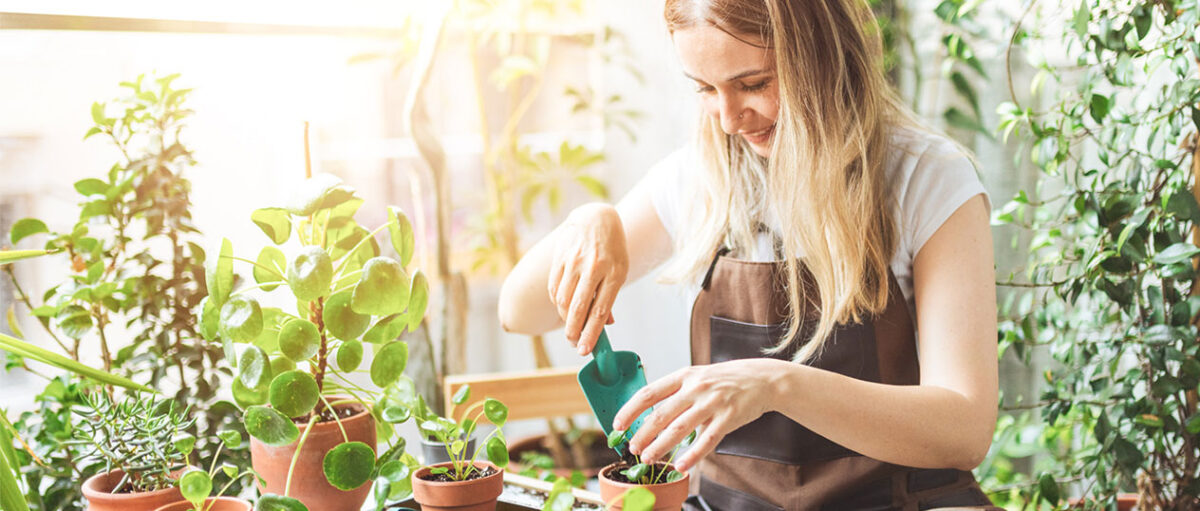Whether you’re cultivating a vegetable crop or planting some beautiful blooms, a garden is a great way to freshen up your home for the spring (and it doesn’t hurt that it boosts your home equity, either). No matter where you fall on the green thumb spectrum—no judgment for the horticulturally challenged among us—there are some easy steps you can take to get your grow on this season. So, ready to learn how to prepare your garden for spring?
How to prepare (and maintain) your garden for spring in 7 steps.
- Clean and organize your tools
- Clear out weeds (and anything else you don’t want in your garden)
- Till and add compost to your soil two weeks before planting
- Buy local seeds and/or plants
- Plant after or around your area’s last frost
- Add mulch (but not too much)
- Watch your hard work pay off
1. Clean and organize your tools.
Before you dive into planting, you’ll need to clean your garden tools.* Start by washing off any excess soil with a hose. Next, let your tools soak in a bucket of hot, soapy water for about 20 minutes. When they’re done soaking, give them a rinse with cold water and dry them off. If your tools are rusty, you can also use vegetable oil and steel wool to remove it. Before storing your tools until you’re ready to plant, don’t forget to disinfect them. You can do this by soaking them in a bucket of water and bleach (two cups of bleach per one gallon of water) for 10 minutes. When the 10 minutes are up, rinse your tools well, dry them off, and store them until you’re ready to use. How’s that for spring cleaning?
*Not sure what tools you need? These are a great place to start:
- Gloves
- Pruners
- Hand trowel
- Hose with an adjustable nozzle
- Garden fork
2. Clear out weeds.
To prepare your garden for spring, you’ll need to clear out weeds, debris, and anything else you don’t want cluttering up your beds (consider this your excuse to say goodbye to that garden gnome your mother-in-law gave you for Christmas). Oh, and don’t forget to wear gloves!
3. Till and add compost to soil.
During the winter, soil tends to dry out and harden. Before planting, you’ll want to till the soil with a hoe, garden fork, or your hands if you’ve got some strong feelings to work out. Next, it’s time to add compost if you have it. Not only does composting reduce waste, it’s also an easy way to increase nutrients in your soil—especially if you’re replanting in an existing garden. Refer to this handy chart to check what you can and can’t compost.
4. Buy local seeds and/or plants.
Buying local helps support your community, and it gives your plants a better chance of thriving. Locally sourced seeds or native plants are naturally better suited to your area’s environment, meaning they’re more likely to reach their full potential as opposed to plants that haven’t adapted for local conditions.
Pro tip: If you’re not sure where to start, find out what plants are native to your area here. Your local farmers market is also an excellent resource.
5. Plant after or around your area’s last frost.
The right time to plant depends on what you’re planting, but in general you’ll want to start after your area’s last frost or a couple of weeks before. It’s never too late to start planting, though. You may just find yourself prepping your garden for summer rather than spring.
6. Add mulch.
After planting, add a layer of mulch to your garden. This will help lock in moisture, feed the soil, and discourage those weeds you worked so hard to get out from growing back. Mulch can also prevent erosion, protect your soil from extreme temperature changes, and keep your plants cleaner. Just don’t put more than two or three inches of mulch over your soil, as this will prevent enough oxygen from reaching the roots.
7. Watch it grow.
Depending on how you look at it, this is either the easiest part or the hardest part. After all that prep, it’s time to sit back and watch your plants grow (don’t forget to water regularly, though). With all that green, your house will be feeling like a home in no time.
Why should I learn how to prepare my garden for spring?
If preparing a garden for spring is starting to sound like a lot of work, you may be wondering if it’s worth it. We certainly think so! Aside from the environmental and emotional benefits that a garden provides, home upgrades like this also boost your equity. When it’s time to refi your mortgage, you can leverage that home equity for better rates or cash out.* You could even use that cash to fund your garden expenses. Win-win.
*Using your home equity to pay off debts or make other purchases does not eliminate the debt or the cost of the purchases, but rather increases the loan amount of your mortgage to be paid according to your new mortgage terms.
A little garden prep goes a long way. Follow our guide to make the most of your outdoor space this spring (and boost your home equity while you’re at it).





